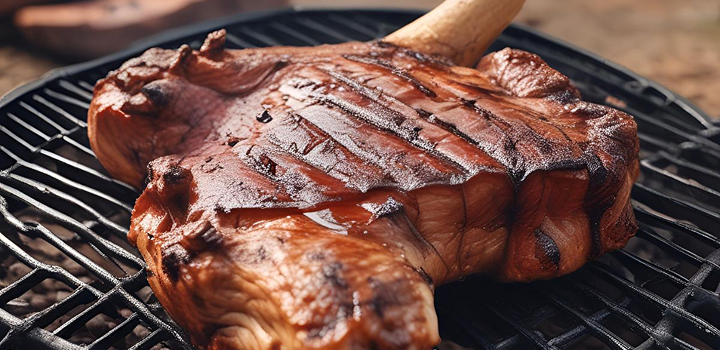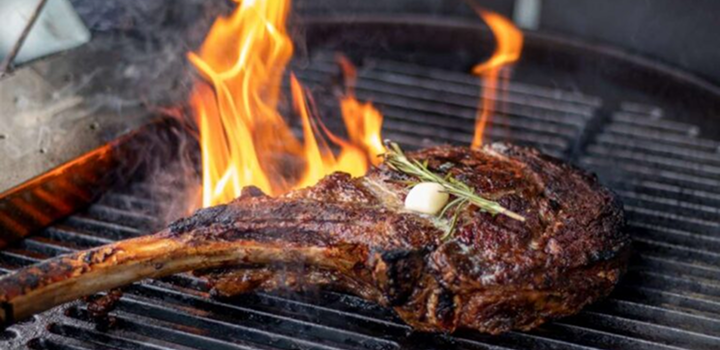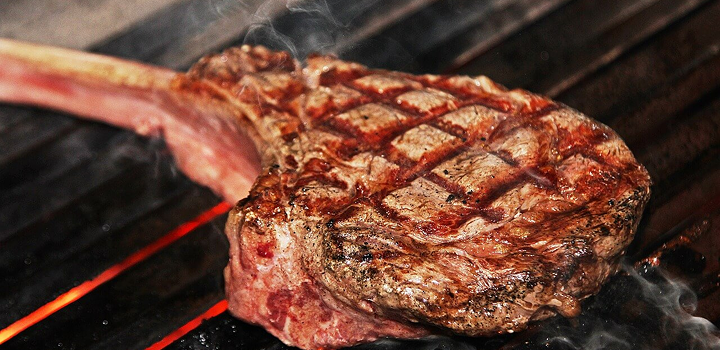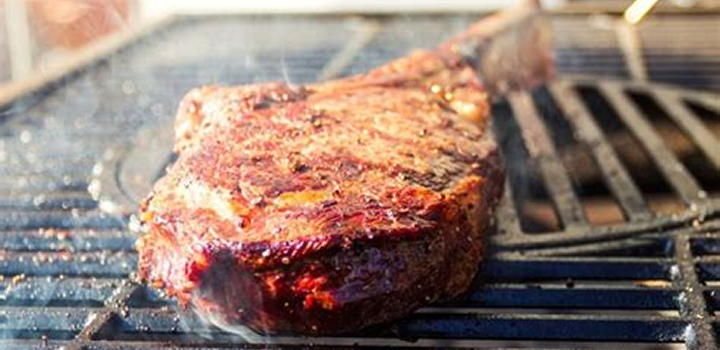Grilling Tomahawk Steak
Grilling Tomahawk Steak: A Straightforward Guide for Beginners

Hi! I am Arianne Nemna.
Few cuts demand attention like a tomahawk steak. Its massive rib bone and thick, marbled meat turn a simple meal into a centerpiece. Cooking it right on the grill brings out deep flavor and a tender bite that’s worth the effort. But with size comes complexity — this guide is your step-by-step manual to getting it right every time.
Understanding the Tomahawk Steak
What Is a Tomahawk Steak?

A tomahawk steak is essentially a ribeye with the bone left in — but not just any bone. The long, frenched rib bone attached to the meat gives it a visual impact that sets it apart. What makes it different from a standard ribeye is the sheer size and the dramatic presentation. You’re typically working with a cut that’s about 2 inches thick and can weigh up to 3 pounds, so cooking it requires different timing and techniques than smaller steaks.
Selecting the Right Cut
Choosing the right tomahawk steak makes all the difference before you even get to the grill. Look for a well-butchered piece with balanced shape and thickness, as this ensures even cooking from edge to bone.
Ideal Marbling and Thickness
The best tomahawk steaks are generously marbled — the streaks of fat you see in the meat are critical for flavor and tenderness. A good cut should have consistent fat dispersion, not just clumps of fat. Aim for a thickness between 1.75 to 2.25 inches. Too thin, and you lose the benefits of reverse-searing. Too thick, and you risk an undercooked center or overcooked outer edge.
Bone Length and Presentation
That extended rib bone isn’t just for show — though it’s certainly part of the appeal. Some tomahawk steaks come with a 5- to 7-inch bone, which helps with even handling during grilling and makes for an impressive final plate. Make sure the bone is cleanly frenched (stripped of meat and fat) for safety and presentation.
Preparing the Steak for the Grill
Seasoning Techniques
There’s no need to complicate seasoning for a tomahawk steak — the beef should be the star. But how and when you apply salt and other flavors matters.

Dry Brining vs. Immediate Seasoning
Dry brining is my preferred method. Apply kosher salt evenly across the surface of the meat and let it sit uncovered in the fridge for 8 to 24 hours. This draws out moisture and then reabsorbs it, seasoning the steak from the inside and improving texture.
If you’re short on time, you can season immediately before grilling. In this case, make sure to coat the steak generously with coarse salt and freshly ground black pepper just before it hits the grill.
When to Add Extra Flavors
If you’re using garlic, herbs, or spice rubs, apply them right after dry brining or immediately after salting if you’re skipping the overnight step. Avoid sugary marinades at this stage — those are better reserved for post-grill finishing or a glaze.
Bringing to Room Temperature
Letting your steak rest on the counter before cooking isn’t just a throwaway tip — it makes a real difference.
Why Temperature Matters for Even Cooking
Going from fridge to flame shocks the meat and can cause uneven doneness — a cold center and an overcooked edge. Allow the steak to sit out for 45 minutes to an hour before grilling. This ensures a more controlled cook, especially when reverse searing or using indirect heat zones on the grill.
Grilling Methods
Reverse Sear Method
The reverse sear is my go-to method for thick steaks like the tomahawk. It’s a two-stage technique: cook the steak gently over indirect heat until nearly done, then finish with a hot sear to create that crust.
Indirect Then High Heat

Start by setting up a two-zone fire on your grill — one side with coals or flame, the other side with none. Place the steak on the cooler side, bone side closest to the heat. Close the lid and let it slowly reach an internal temperature of about 115–120°F for medium rare.
Once you’re there, move the steak to the hot side of the grill. Flip every 30 seconds to avoid burning while building up a crisp outer layer. This step only takes a few minutes and should bring the final temperature up to 130–135°F, depending on your preference.
Pros of the Reverse Sear for Thick Cuts
This method gives you even doneness from edge to center without overcooking the exterior. It’s also more forgiving. You control the finish instead of rushing it, and the final sear gives you that restaurant-quality crust that people expect from a tomahawk steak.
Traditional Sear Method
If you don’t have the time or setup for a two-zone grill, the traditional sear-first method can still yield great results. The goal here is to create a crust right away, then finish cooking with gentler heat.
Getting a Great Crust First
Start with a well-oiled, preheated grill on high heat. Place the steak directly over the flames for about 2–3 minutes per side. You’re not trying to cook the whole steak yet — just build the outer texture. Don’t press it down or move it too much. Let the grill do the work.
Managing Internal Temperature After Searing
Once the exterior is well-seared, move the steak to the cooler part of the grill or reduce the heat to medium. Cover the lid and continue cooking until it reaches your target internal temperature. It helps to monitor every few minutes because things move quickly after the initial sear.
Monitoring Doneness
Using a Meat Thermometer
A meat thermometer is essential when working with a thick tomahawk. Guessing leads to uneven results, especially with variable heat zones on the grill.
Internal Temperature Chart by Doneness Level
| Doneness | Pull from Grill at | Final Temp (after resting) |
| Rare | 115°F | 120°F |
| Medium Rare | 125°F | 130°F |
| Medium | 135°F | 140°F |
| Medium Well | 145°F | 150°F |
| Well Done | 155°F | 160°F |
These numbers reflect internal temperature at the thickest part of the steak, not touching bone or fat.
Where to Insert the Thermometer Correctly
Slide the thermometer probe into the side of the steak, not from the top. You want the tip to land in the very center of the meat’s thickest portion. Avoid bone, as it can distort the reading and suggest the meat is hotter than it really is.
Resting the Steak
Resting is not optional — it’s essential. Once you hit your target temp, the steak still needs a few minutes off the grill to finish cooking internally and redistribute juices.
Carryover Cooking Explained
Carryover cooking is the rise in internal temperature after meat is removed from heat. A thick cut like a tomahawk can increase by 5–10°F just by resting. That’s why you pull it early.
Retaining Juices for Better Texture
Place the steak on a cutting board and loosely cover it with foil for 10–15 minutes. Don’t cut into it too soon or all those savory juices you worked to lock in will spill out. Patience here pays off with a juicier, more tender bite.
Serving Suggestions
Carving the Steak

Once your steak has rested, it’s time to carve it properly. The presentation is just as important as the flavor, especially with a dramatic cut like a tomahawk.
Slicing Against the Grain
Look at the meat’s surface to find the direction of the muscle fibers. Slice perpendicular to those fibers to keep each bite tender. Use a long, sharp carving knife and make clean, even cuts that are about half an inch thick.
Bone-In Serving Presentation Tips
If you want to present it whole for dramatic flair, slice the meat completely from the bone first, then reassemble it beside the bone on the platter. This gives your guests the visual impact of the full tomahawk while still making it easy to serve and eat.
Accompaniments
A richly marbled steak benefits from balance on the plate. Choose sides that complement rather than compete.
Best Side Dishes for Balance
Grilled asparagus, roasted potatoes, or a crisp arugula salad work beautifully. Acidic or slightly bitter sides help cut through the richness of the meat. Corn on the cob or charred green beans also bring texture and color contrast.
Ideal Sauces and Condiments
You don’t need much, but a dollop of chimichurri, horseradish cream, or a red wine reduction can elevate the flavor. Even a drizzle of herb-infused oil or garlic butter adds a finishing touch without overpowering the steak.
Tips and Tricks
Avoiding Common Mistakes
Even the best cut can go wrong if you overlook key details. Here’s how to stay on track.
Monitoring Grill Zones
Always know which part of your grill is hottest. The reverse sear method depends on keeping indirect heat low and steady. Use a grill thermometer or hand test to gauge temperature, and rotate your steak if needed to avoid hot spots.
Letting the Steak Breathe After Cooking

Resting isn’t just about carryover cooking — it also gives fibers time to relax. That’s how you avoid juice loss when slicing. Don’t rush it. The steak should feel warm to the touch but not hot when you carve.
Enhancing Flavor
You’ve already chosen a premium cut — now give it that little extra character.
Wood Chips and Smoke Enhancers
Add soaked wood chips to your charcoal or a smoker box on your gas grill. Hickory adds punch, cherry brings sweetness, and oak gives balance. Let the smoke surround the steak during the first slow-cook phase to infuse subtle layers of flavor.
Compound Butters and Finishing Touches
Make a compound butter with softened butter, garlic, thyme, and lemon zest. Drop it on top of the steak just as it comes off the grill. It melts into the surface, boosting aroma and richness in one elegant move.
15+ Frequently Asked Questions
How thick should a tomahawk steak be for grilling?
Aim for a thickness of 1.5 to 2.5 inches. Anything thinner risks overcooking before developing a crust.
Do I need to let the steak come to room temperature before grilling?
Yes, let it sit out for about 45 minutes. This helps it cook evenly inside and out.
Is the bone just for presentation?
The long rib bone adds visual drama and may help with heat conduction near the meat, but its primary role is aesthetic.
Can I grill a frozen tomahawk steak?
It’s not recommended. Always thaw fully in the fridge before cooking for consistent results.
How long should I rest the steak after grilling?
Let it rest for 10 to 15 minutes. This prevents juice loss and allows the internal temperature to stabilize.
Can I use a gas grill instead of charcoal?
Yes, but use a smoker box or foil packet with wood chips to add smoky flavor.
What’s the best internal temperature for medium rare?
Pull it off the grill at 125°F and let it rest to 130–135°F.
Should I oil the grill grates before cooking?
Yes. Preheat, clean, and then oil the grates to prevent sticking and ensure clear sear marks.
Do I need to flip the steak multiple times?
For a seared crust, flip every 30–45 seconds during the final high-heat phase.
Can I reuse leftover steak?
Absolutely. Slice thinly and use in steak sandwiches, tacos, or salads.
What rubs work best with tomahawk steak?
Simple salt and pepper always work, but you can add garlic powder, smoked paprika, or ground mustard for extra flavor.
What oil should I use for grilling?
Choose oils with high smoke points like avocado, grapeseed, or canola oil.
Can I marinate the steak beforehand?
It’s not necessary with such a premium cut, but a dry brine or rub works well. Avoid acidic marinades that break down texture.
Should I use a grill press or weight?
No, pressing down forces juices out and flattens the meat. Let the grill do the work naturally.
Can I sous vide the steak before grilling?
Yes, sous vide at 120°F, then sear on high heat. This gives you precision and a perfect crust.







